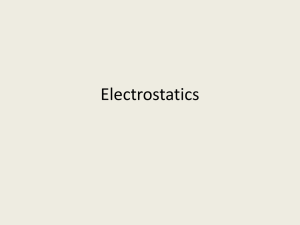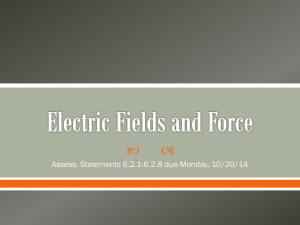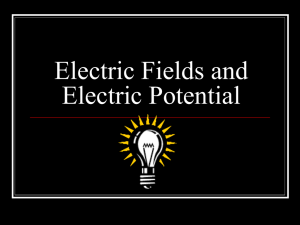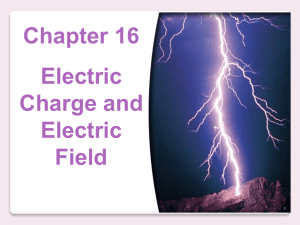Document 10343950
advertisement
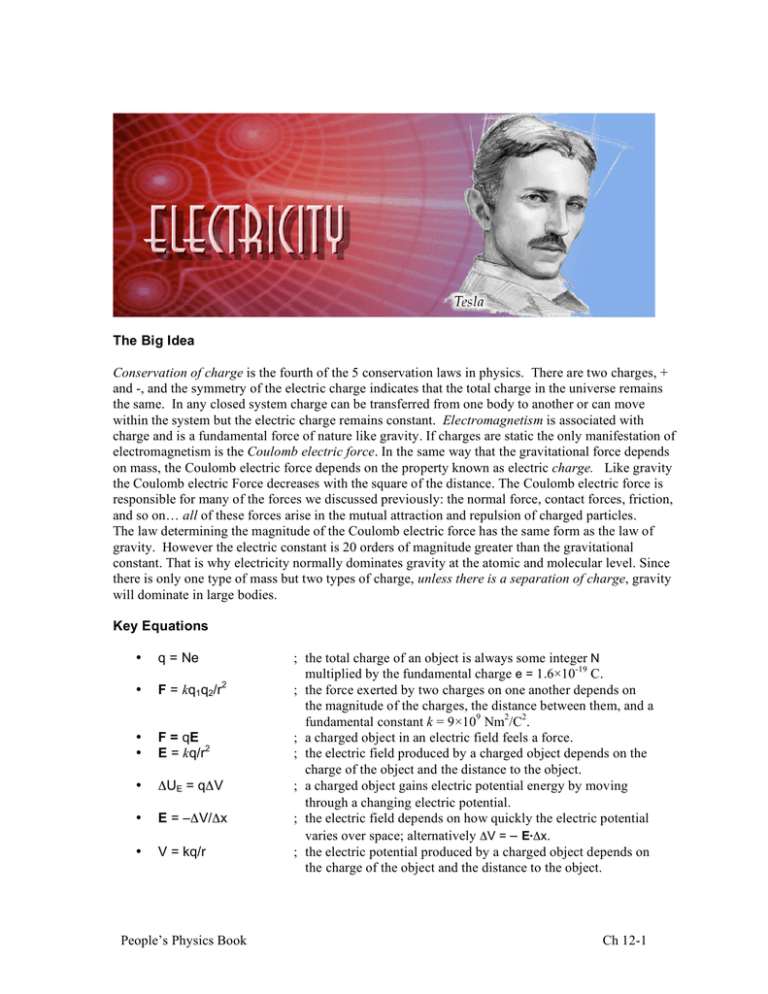
The Big Idea Conservation of charge is the fourth of the 5 conservation laws in physics. There are two charges, + and -, and the symmetry of the electric charge indicates that the total charge in the universe remains the same. In any closed system charge can be transferred from one body to another or can move within the system but the electric charge remains constant. Electromagnetism is associated with charge and is a fundamental force of nature like gravity. If charges are static the only manifestation of electromagnetism is the Coulomb electric force. In the same way that the gravitational force depends on mass, the Coulomb electric force depends on the property known as electric charge. Like gravity the Coulomb electric Force decreases with the square of the distance. The Coulomb electric force is responsible for many of the forces we discussed previously: the normal force, contact forces, friction, and so on… all of these forces arise in the mutual attraction and repulsion of charged particles. The law determining the magnitude of the Coulomb electric force has the same form as the law of gravity. However the electric constant is 20 orders of magnitude greater than the gravitational constant. That is why electricity normally dominates gravity at the atomic and molecular level. Since there is only one type of mass but two types of charge, unless there is a separation of charge, gravity will dominate in large bodies. Key Equations • q = Ne • F = kq1q2/r2 • • F = qE E = kq/r2 • ΔUE = qΔV • E = –ΔV/Δx • V = kq/r People’s Physics Book ; the total charge of an object is always some integer N multiplied by the fundamental charge e = 1.6×10-19 C. ; the force exerted by two charges on one another depends on the magnitude of the charges, the distance between them, and a fundamental constant k = 9×109 Nm2/C2. ; a charged object in an electric field feels a force. ; the electric field produced by a charged object depends on the charge of the object and the distance to the object. ; a charged object gains electric potential energy by moving through a changing electric potential. ; the electric field depends on how quickly the electric potential varies over space; alternatively ΔV = – E·Δx. ; the electric potential produced by a charged object depends on the charge of the object and the distance to the object. Ch 12-1 Key Concepts • • • • • • Electrons have negative charge and protons have positive charge. The magnitude of the charge is the same for both, e. In any process, electric charge is conserved. The total electric charge of the universe does not change. Therefore, electric charge can only be transferred – not lost – from one body to another. Normally, electric charge is transferred when electrons leave the outer orbits of the atoms of one body (leaving it positively charged) and move to the surface of another body (causing the new surface to gain a negative net charge). In a plasma all electrons are stripped from the atoms, leaving positively charged ions and free electrons. Similarly-charged objects have a repulsive force between them. Oppositely charged objects have an attractive force between them. The value of the electric field tells you the force that a charged object would feel if it entered this field. Electric field lines tell you the direction a positive charge would go if it were placed in the field. Electric potential is measured in units of Volts (V) – thus electric potential is often referred to as “voltage.” Electric potential is the source of the electric potential energy. Positive charges move towards lower electric potential; negative charges move toward higher electric potential Key Applications • • • In problems that ask for excess negative or positive charge, remember that each electron has one unit of the fundamental charge e. To find the speed of a particle after it traverses a voltage difference, use the equation for the conservation of energy: qΔV = ½mv2 Force and electric field are vectors. Use your vector math skills (i.e. keep the x and y directions separate) when solving two-dimensional problems. People’s Physics Book Ch 12-2 Electricity Problem Set 1. After sliding your feet across the rug, you touch the sink faucet and get shocked. Explain what is happening. 2. What is the net charge of the universe? Of your toaster? 3. As you slide your feet along the carpet, you pick up a net charge of +4 mC. Which of the following is true? a. b. c. d. You have an excess of You have an excess of You have an excess of You have an excess of 2.5 !1016 electrons 2.5 !1019 electrons 2.5 !1016 protons 2.5 !1019 protons 4. You rub a glass rod with a piece of fur. If the rod now has a charge of –0.6 µC, how many electrons have been added to the rod? a. 3.75 !1018 b. 3.75 !1012 c. 6000 d. 6.00 !1012 e. Not enough information 5. What is the direction of the electric field if an electron initially at rest begins to move in the North direction as a result of the field? a. b. c. d. e. North East West South Not enough information 6. Two metal plates have gained excess electrons in differing amounts through the application of rabbit fur. The arrows indicate the direction of the electric field which has resulted. Three electric potential lines, labeled A, B, and C are shown. Order them from the greatest electric potential to the least. a. b. c. d. e. A, B, C C, B, A B, A, C B, C, A A = B = C … they’re all at the same potential People’s Physics Book Ch 12-3 C 7. The diagram to the right shows a negatively charged electron. Order the electric potential lines from greatest to least. A B – a. A, B, C b. C, B, A c. B, A, C d. B, C, A e. A = B = C … they’re all at the same electric potential 8. The three arrows shown here represent the magnitudes of the electric field and the directions at the tail end of each arrow. Consider the distribution of charges which would lead to this arrangement of electric fields. Which of the following is most likely to be the case here? a. A positive charge is located at point A b. A negative charge is located at point B c. A positive charge is located at point B and a negative charge is located at point C d. A positive charge is located at point A and a negative charge is located at point C e. Both answers a) and b) are possible A C B 9.. Particles A and B are both positively charged. The arrows shown indicate the direction of the forces acting on them due to an applied electric field (not shown in the picture). For each, draw in the electric field lines that would best match the observed force. c. a. e. A A B A B B b. d. A B A 10. To the right are the electric potential lines for a certain arrangement of charges. Draw the direction of the electric field for all the black dots. B 2V 10 V 6V People’s Physics Book Ch 12-4 11.. A suspended pith ball possessing +10 µC of charge is placed 0.02 m away from a metal plate possessing –6 µC of charge. a. Are these objects attracted or repulsed? b. What is the force on the negatively charged object? c. What is the force on the positively charged object? 12. Calculate the electric field a distance of 4.0 mm away from a –2.0 µC charge. Then, calculate the force on a –8.0 µC charge placed at this point. 13. Consider the hydrogen atom. Does the electron orbit the proton due to the force of gravity or the electric force? Calculate both forces and compare them. (You may need to look up the properties of the hydrogen atom to complete this problem.) 14. As a great magic trick, you will float your little sister in the air using the force of opposing electric charges. If your sister has 40 kg of mass and you wish to float her 0.5 m in the air, how much charge do you need to deposit both on her and on a metal plate directly below her? Assume an equal amount of charge on both the plate and your sister. 15. Copy the arrangement of charges below. Draw the electric field from the –2 C charge in one color and the electric field from the +2 C charge in a different color. Be sure to indicate the directions with arrows. Now take the individual electric field vectors, add them together, and draw the resultant vector. This is the electric field created by the two charges together. –2 C +2 C 16. A proton traveling to the right moves inbetween the two large plates. A vertical electric field, pointing downwards with magnitude 3.0 N/C, is produced by the plates. a. What is the direction of the force on the proton? b. Draw the electric field lines on the diagram. c. If the electric field is 3.0 N/C, what is the acceleration of the proton in the region of the plates? d. Pretend the force of gravity doesn’t exist; then sketch the path of the proton. e. We take this whole setup to another planet. If the proton travels straight through the apparatus without deflecting, what is the acceleration of gravity on this planet? People’s Physics Book Ch 12-5 17. A molecule shown by the square object shown below contains an excess of 100 electrons. a. What is the direction of the electric field at point A, 2.0×10-9 m away? A b. What is the value of the electric field at point A? c. A molecule of charge 8.0 µC is placed at point A. What are the magnitude and direction of the force acting on this molecule? 18. Two negatively charged spheres (one with –12 µC; the other with –3 µC) are 3 m apart. Where could you place an electron so that it will be suspended in space between them with zero net force? For problems 19, 20, and 21 assume 3-significant digit accuracy in all numbers and coordinates. All charges are positive. 19. Find the direction and magnitude of the force on the charge at the origin (see picture to the right). The object at the origin has a charge of 8 µC, the object at coordinates (–2 m, 0) has a charge of 12 µC, and the object at coordinates (0, –4 m) has a charge of 44 µC. All distance units are in meters. –2 20. A 2 C charge is located at the origin and a 7 C charge is located at (0, 6 m). Find the electric field at the coordinate (10 m, 0). It may help to draw a sketch. –4 21. A metal sphere with a net charge of +5 µC and a mass of 400 g is placed at the origin and held fixed there. a. Find the electric potential at the coordinate (6 m, 0). b. If another metal sphere of –3 µC charge and mass of 20 g is placed at the coordinate (6 m, 0) and left free to move, what will its speed be just before it collides with the metal sphere at the origin? +5 µC –3 µC 6m People’s Physics Book Ch 12-6 22. Collisions of electrons with the surface of your television set give rise to the images you see. How are the electrons accelerated to high speed? Consider the following: two metal plates (The right hand one has small holes allow electrons to pass through to the surface of the screen.), separated by 30 cm, have a uniform electric field between them of 400 N/C. a. Find the force on an electron located at a point midway between the plates b. Find the voltage difference between the two plates c. Find the change in electric potential energy of the electron when it travels from the back plate to the front plate d. Find the speed of the electron just before striking the front plate (the screen of your TV) 23. Two pith balls of equal and like charges are repulsed from each other as shown in the figure below. They both have a mass of 2 g and are separated by 30°. One is hanging freely from a 0.5 m string, while the other, also hanging from a 0.5 m string, is stuck like putty to the wall. a. Draw the free body diagram for the hanging pith ball b. Find the distance between the leftmost pith ball and the wall (this will involve working a geometry problem) c. Find the tension in the string (Hint: use ydirection force balance) d. Find the amount of charge on the pith balls (Hint: use x-direction force balance) People’s Physics Book Ch 12-7 People’s Physics Book Ch 12-8
